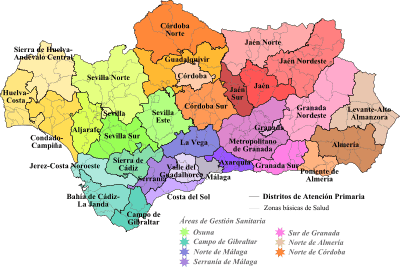Andalusian Health Service
The Andalusian Health Service (Spanish: Servicio Andaluz de Salud, SAS), the government-run health system for the autonomous community of Andalusia, Spain, was created under Ley 8/1986 de 6 de mayo (Spanish law 8/1986, 6 May 1986), as an autonomous agency attached to the Council of Health (Consejería de Salud) of the Andalusian Autonomous Government, and belonging to the Andalusian Public Health System (Sistema Sanitario Público Andaluz, SSPA). Part of the Spanish National Health System (Sistema Nacional de Salud, SNS).[1]
| Servicio Andaluz de Salud (SAS) | |
Official Logo | |
| Health service overview | |
|---|---|
| Formed | 1986-05-06 |
| Preceding Health service |
|
| Jurisdiction | Andalusia, Spain |
| Employees | 83,132 professionals |
| Parent Health service | Andalusian Autonomous Government |
| Website | www |
As of 1 January 2007, the SAS employs 83,132 professionals, 20,810 of them in primary care and 62,322 in specialized care.
Decree 241/2004 establishes the basic organic structure of the Council of Health and the SAS. It is compose of the following directive centers:
- Direction-Management
- General Secretariat
- Directorate General of Health Services
- Directorate General of Personnel and of Professional Development
- Directorate General of Economic Management
Functions of the SAS
Article 13.3 of Decree 241/2004 of 18 May establishes the functions of the SAS:
- Management of health services in the field of promotion and protection of health, prevention of disease, health care and rehabilitation as applicable to the territory of the Autonomous Community of Andalusia
- Administration and management of the institutions, centers and of those health services that are under their dependency, organically and functionally.
- Management of the financial, material and human resources needed to fulfill these functions.
Its functions are further delineated by:
- Ley 2/1998 de Salud de Andalucía (Law 2/1998 on the Health of Andalusia)[2]
- III Plan Andaluz de Salud 2003-2008 (Andalusian Health Plan III).
- The quality plan of the Andalusian Public Health System (SSPA).
- The SAS's own strategic plan.
Competencies an organization of the SAS

Primary care
Ley 2/1998 establishes a primary health care system for Andalusia. This is the first level of access for the people of Andalusia to the SSPA. Among its characteristic elements is the availability of integrated health services including preventive, curative and rehabilitative care. It is also responsible for the promotion of health, for health-related education, and for monitoring the environment with respect to health.
As of 1 January 2007 there are 1,452 primary care centers in Andalusia, located so that all citizens can readily reach such a center by public transport.
The smallest geographical unit used in organizing primary care services are the districts known as zonas básicas de salud ("basic health zones"). Each zone includes one or more primary care centers, offering health care to the population. A level up from these are districts with the organizational structures to plan, direct, manage and administer these.[3] Most recently (as of 2010) these have been enumerated by 197/2007.
Above and beyond these are Health Management Areas (Áreas de Gestión Sanitaria), established by separate legislation:
- Área de Gestión Sanitaria de Osuna (Province of Sevilla), regulated by Decree 69/1996
- Área de Gestión Sanitaria Norte de Córdoba, Decree 68/1996
- Área de Gestión Sanitaria Campo de Gibraltar, regulated by Order of 2 December 2002
- Área de Gestión Sanitaria Norte de Almería, Order of 5 October 2006
- Área de Gestión Sanitaria Serranía de Málaga, Order of 5 October 2006
- Área de Gestión Sanitaria Norte de Málaga, Order of 5 October 2006
- Área de Gestión Sanitaria Sur de Granada, Order of 5 October 2006
Specialized medicine
Specialty care is defined under Ley 2/1998 as the second level of care.[2] Specialty care provides the technical and human capabilities appropriate to diagnosis, treatment and rehabilitation for conditions that cannot be handled at the primary level.
In coordination with the primary level, hospitals and their specialty centers form the necessary structure to provide this care.[4] Ésta suele ser programada y urgente, desarrollando además funciones de promoción de la salud, prevención de enfermedades, asistencia curativa y rehabilitación, así como docencia e investigación. This includes both scheduled and urgent care, and, like the primary care, encompasses health promotion, disease prevention, curative care and rehabilitation as well as teaching and research.
Hospitals and other centers
SAS manages and operates 29 hospitals throughout Andalusia. In addition they manage and operate numerous more specialized facilities:
- Blood transfusion centers, responsible for the supply of blood and derived blood products to public and private hospitals in Andalusia. The Regional Transfusion Centers also constitute Sectorial Tissue Banks, charged with the study, preparation and conservation of bodily tissues.
- Mental Health Program, a network of mental health centers organized into:
- District Mental Health Teams
- Child/Youth Mental Health Units
- Mental Health Rehabilitation Units
- Outpatient Mental Health Hospitals
- Inpatient Mental Health Hospitals
- Therapeutic Mental Health Communities
- Autonomic Coordination of Transplants
- Urgent and Emergency Care
- User Care Services (Servicios de Atención al Usuario, SAU), in every health center or hospital
Notes
- Ley 8/1986 de 6 de mayo, de Creación del Servicio Andaluz de Salud, SAS, Junta de Andalucía.
- Ley 2/1998 de Salud de Andalucía, Junta de Andalucía.
- See Consejera de Salud, BOJA nm. 70, 2002-06-15, p. 10.368 et. seq. for a detailed listing of the zonas básicas and how they are grouped.
- Decreto 462/1996 de 8 de octubre, sobre Ordenación de asistencia sanitaria especializada y órganos de dirección de los hospitales de la Asistencia Especializada.
External links
- (in Spanish) Servicio Andaluz de Salud, official site
- (in Spanish) Ley 8/1986 de 6 de mayo, de Creación del Servicio Andaluz de Salud (law creating the SAS)
- (in Spanish) Distritos de Atención Sanitaria (districts)
- (in Spanish) Donación de Sangre en Centros Regionales de Transfusión Sanguínea (blood donation)